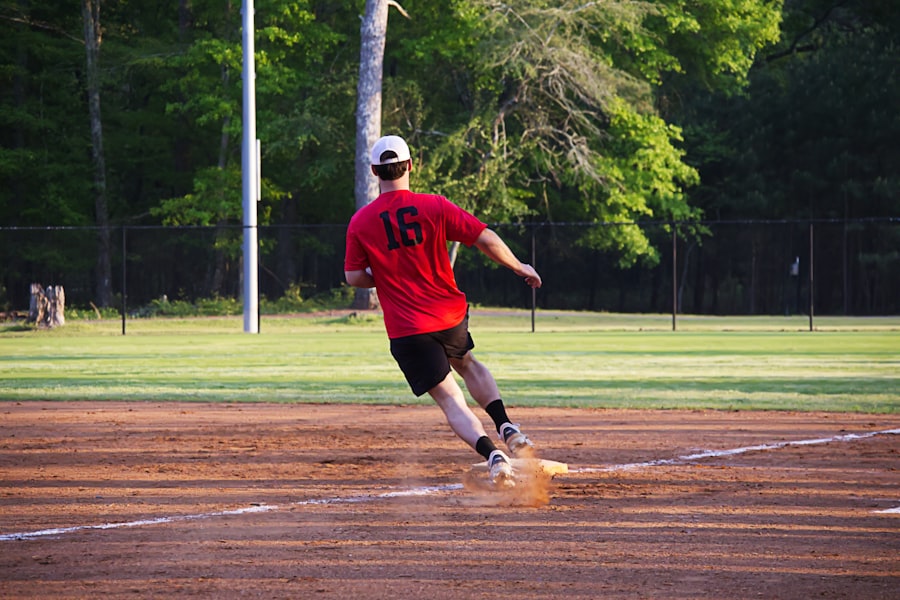Download links
How to install Mastering the Art of Softball: Tips for Success APK?
1. Tap the downloaded Mastering the Art of Softball: Tips for Success APK file.
2. Touch install.
3. Follow the steps on the screen.
Description
Softball is a bat-and-ball sport that shares many similarities with baseball but has its own unique set of rules and gameplay dynamics. Originating in the late 19th century, softball has evolved into a popular sport played at various levels, from recreational leagues to professional competitions. The game is typically played on a diamond-shaped field, featuring four bases arranged in a square.
The objective is to score runs by hitting the ball and successfully reaching each base before the opposing team can make an out. The standard dimensions of a softball field differ from those of baseball, with the distance between bases being 60 feet and the pitcher’s mound located 43 feet from home plate in fast-pitch softball. The game can be played in two primary formats: fast-pitch and slow-pitch.
Fast-pitch softball emphasizes speed and skill, with pitchers delivering the ball at high velocities, often exceeding 60 miles per hour. In contrast, slow-pitch softball allows for a more leisurely pace, with pitchers throwing the ball in an arc that must reach a certain height before crossing the plate. Each format has its own set of strategies and techniques, making it essential for players to understand the nuances of the version they are participating in.
Additionally, the equipment used in softball, such as bats, gloves, and balls, is specifically designed to cater to the unique demands of the game, further distinguishing it from baseball.
Key Takeaways
- Softball is a team sport similar to baseball, played with a larger ball on a smaller field.
- Essential skills in softball include throwing, catching, hitting, and base running.
- Improving batting techniques involves proper stance, grip, and timing for successful hits.
- Fielding abilities can be enhanced through agility, quick reflexes, and proper positioning on the field.
- Mastering pitching and catching requires focus, accuracy, and communication between the pitcher and catcher.
Developing Essential Skills
To excel in softball, players must develop a range of fundamental skills that form the foundation of their performance on the field. These skills include hitting, throwing, catching, and base running. Mastery of these core abilities is crucial for both individual success and overall team performance.
For instance, a player who can consistently hit the ball with power and precision not only increases their chances of getting on base but also contributes to the team’s offensive strategy. Similarly, strong throwing and catching skills are vital for defensive players, as they enable them to make accurate plays and prevent runs from scoring. Practicing these essential skills requires dedication and repetition.
Players often engage in drills that focus on specific aspects of their game. For example, hitting drills may involve using batting tees or soft toss to improve swing mechanics and hand-eye coordination. Throwing drills can include partner exercises or target practice to enhance accuracy and arm strength.
Catching drills often emphasize glove work and foot positioning to ensure players can field ground balls and catch fly balls effectively. By consistently honing these skills through targeted practice, players can build a solid foundation that will serve them well throughout their softball careers.
Improving Batting Techniques

Batting is one of the most critical components of softball, as it directly impacts a team’s ability to score runs. To improve batting techniques, players must focus on several key elements: stance, grip, swing mechanics, and timing. A proper batting stance sets the stage for an effective swing; players should adopt a balanced position with their feet shoulder-width apart and knees slightly bent.
This stance allows for better weight transfer during the swing, which is essential for generating power. The grip on the bat also plays a significant role in batting performance. Players should hold the bat firmly but not too tightly, allowing for flexibility in their wrists during the swing. A common technique is to align the knuckles of the top hand with those of the bottom hand, creating a more natural swing path. Swing mechanics involve a coordinated movement of the hips, shoulders, and arms; players should focus on initiating their swing with their lower body while keeping their upper body relaxed.
Timing is equally important; players must learn to recognize pitch types and speeds to make contact effectively. Drills that simulate different pitch scenarios can help players develop their timing and improve their overall batting performance.
Enhancing Fielding Abilities
| Player Name | Catches | Run Outs | Throw Accuracy (%) |
|---|---|---|---|
| Player 1 | 20 | 5 | 85% |
| Player 2 | 15 | 3 | 90% |
| Player 3 | 25 | 7 | 80% |
Fielding is an essential aspect of softball that requires agility, quick reflexes, and strong hand-eye coordination. Players must be adept at catching both ground balls and fly balls while also being able to make accurate throws to bases. To enhance fielding abilities, players should engage in various drills that focus on different aspects of fielding techniques.
For instance, ground ball drills can help players improve their ability to field balls hit along the ground by emphasizing proper glove positioning and footwork. Fly ball drills are equally important; players must practice tracking the ball’s trajectory and positioning themselves correctly to make catches. A common technique involves using a “drop step” to quickly move back when anticipating a fly ball hit over their heads.
Additionally, players should work on their throwing mechanics to ensure they can make accurate throws to bases after fielding a ball. This includes practicing proper footwork when transitioning from fielding to throwing, as well as developing arm strength through targeted conditioning exercises.
Mastering Pitching and Catching
Pitching and catching are two of the most specialized positions in softball, requiring unique skills and a deep understanding of game strategy. A successful pitcher must possess a variety of pitches—such as fastballs, change-ups, and curveballs—to keep batters guessing and off-balance. Mastery of pitching mechanics is crucial; pitchers should focus on their windup, release point, and follow-through to ensure accuracy and velocity.
Regular practice sessions that include bullpen work can help pitchers refine their techniques while also building arm strength. Catching complements pitching by providing support behind the plate. A skilled catcher must be adept at framing pitches to help pitchers get favorable calls from umpires while also being able to block balls in the dirt to prevent runners from advancing.
Communication between pitchers and catchers is vital; they must work together to develop game plans based on opposing hitters’ tendencies. Catchers also play a crucial role in controlling the running game by making quick throws to bases when attempting to catch stealing runners. Drills that simulate game situations can help both pitchers and catchers develop their skills while fostering teamwork.
Building Teamwork and Communication

Team-Building Activities
These activities can range from simple icebreakers to more complex challenges that require problem-solving skills and cooperation.
On-Field Communication
On-field communication is equally important; players must develop signals and verbal cues to convey information quickly during games. For example, infielders may use specific hand signals to indicate whether they are going for a pop-up or letting it drop for a play at another base.
Practice Drills
Outfielders need to communicate effectively with infielders when tracking fly balls to avoid collisions. Regular practice sessions should include drills that emphasize communication skills, allowing players to become accustomed to calling out plays or relaying information during high-pressure situations.
Mental Preparation and Focus
Mental preparation is often overlooked in sports training but is crucial for achieving peak performance in softball. Players must develop mental resilience to handle the pressures of competition while maintaining focus throughout games. Visualization techniques can be beneficial; athletes often use mental imagery to picture themselves successfully executing plays or making critical hits during games.
This practice helps build confidence and reduces anxiety by familiarizing players with various game scenarios. Additionally, mindfulness exercises can enhance concentration levels during games. Techniques such as deep breathing or meditation can help players stay present and focused on the task at hand rather than becoming distracted by external factors or past mistakes.
Coaches can incorporate mental training into regular practice sessions by including discussions about goal-setting or strategies for overcoming challenges during games. By prioritizing mental preparation alongside physical training, players can cultivate a winning mindset that contributes significantly to their overall performance.
Training and Conditioning for Peak Performance
To achieve peak performance in softball, athletes must engage in comprehensive training and conditioning programs that address both physical fitness and sport-specific skills. Strength training is essential for building muscle power, which translates into improved batting strength and throwing velocity. Exercises such as squats, lunges, and deadlifts can enhance lower body strength while upper body workouts like bench presses and rows contribute to overall power development.
In addition to strength training, cardiovascular conditioning plays a vital role in maintaining endurance throughout games. Softball players often engage in interval training or agility drills that mimic game situations—such as sprinting between bases or performing quick lateral movements—to improve their speed and agility on the field. Flexibility training should not be neglected either; incorporating stretching routines into training regimens helps prevent injuries while enhancing overall mobility.
Hydration is equally important; athletes should ensure they are adequately hydrated before, during, and after physical activity to optimize performance and recovery. By focusing on these various aspects of training and conditioning—strength building, cardiovascular fitness, flexibility enhancement, nutrition management—softball players can develop into well-rounded athletes capable of excelling at all levels of competition.
FAQs
What is softball?
Softball is a bat-and-ball sport that is similar to baseball. It is played on a smaller field and with a larger ball.
How is softball played?
Softball is played between two teams of nine players each. The game consists of innings, with each team taking turns to bat and field.
What are the basic rules of softball?
The basic rules of softball include pitching the ball underhand, hitting the ball with a bat, running the bases, and fielding to get the opposing players out.
What equipment is used in softball?
The equipment used in softball includes a bat, a ball, gloves for fielding, helmets for batting, and protective gear for the catcher.
What are the different types of softball?
There are two main types of softball: fastpitch and slowpitch. Fastpitch softball is played with a larger ball and faster pitching, while slowpitch softball is played with a smaller ball and slower pitching.
What are the health benefits of playing softball?
Playing softball can help improve cardiovascular health, strength, agility, and hand-eye coordination. It also promotes teamwork and social interaction.





